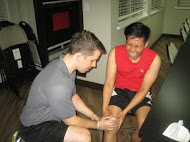Ballistic trauma pertains to a kind of physical trauma that is typically obtained from the discharge of weaponries or armaments. It is also called a gunshot wound. This particular type of trauma is commonly seen in wars and street violence. Ballistic trauma can often lead to life threatening consequences to the recipient, especially if shot in the most vulnerable areas, which are the head and the torso.
The injury caused by a bullet is related to the kinetic energy of the bullet. The high velocity from the bullet released causes damage to the surrounding tissues rather than confining the path it took internally. It causes laceration and crushing to the tissues in its path. It generally creates a cavity that is 30 times wider than the path it takes and in less than a second after the bullet passes, the cavity closes behind the bullet. But the cavitation will lead to damage to the tissues, organs, and bones through shock waves.
Causes of Ballistic Trauma
The following are the most common causes of ballistic trauma in an individual:
- Armed conflicts
- Civilian sporting
- Recreational pursuits
- Criminal activities
Signs and Symptoms of Ballistic Trauma
It is usually easy to determine when an individual has sustained a ballistic trauma as gunshots or blasts are heard. However, in some cases where it is not heard and the patient is unconscious, the following signs and symptoms may be observed in ballistic trauma:
- Entry and exit wound, in some cases, there is only an entry wound (the entry is typically smaller than the exit wound)
- Severe bleeding
- Bleeding from the mouth, rectum or genitals
- Deformity
- Pain
- Swelling
- Unable to move affected area
First Aid Management of Ballistic Trauma
It is necessary to give first aid to victims of ballistic trauma immediately. Nevertheless, ensure that the environment is safe before attempting to give aid to the victim. Immediately call for emergency medical services. The following is generally recommended in cases of ballistic trauma:
- If there is protective gear available, wear them.
- Apply direct pressure to the wound to cease the bleeding. Use an absorbent cloth or dressing. It is necessary to keep the pressure in place. Apply new dressings over the old ones instead of removing the soaked dressings to avoid disturbance.
Applying direct pressure is necessary to control bleeding caused by ballistic trauma - Check for the victim’s circulation, airway, breathing, disability/ deformity and exposure. If necessary, initiate CPR.
- Do not move the victim unless it is necessary, such as dangerous surroundings.
- Be prepared to treat the victim for shock.
Ballistic trauma pertains to a kind of physical trauma that is typically obtained from discharge of weaponries. To learn how to properly administer first aid and CPR in cases of ballistic trauma and other kinds of trauma, enroll in First Aid and CPR Courses.
Online Sources:
http://en.wikipedia.org/wiki/Ballistic_trauma
http://science.howstuffworks.com/life/human-biology/best-place-to-get-shot1.htm

